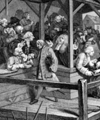January
Raining cats and dogs – running for power in the past

Modern politicians may feel they have it tough – but they should thank their lucky stars they weren’t standing for election in the Westminster constituency in 1741.
On that occasion, angry voters pelted the candidates and the tellers with dead cats and dogs, dirt, stones and sticks.
It’s a striking image, which fits with a Hogarthian view of the eighteenth century. Yet experts from Newcastle University argue that such rumbustious episodes were very far from the whole story. They are putting the full history of London’s elections under the spotlight to present a new view.
Their arguments and evidence are freely available in a new website, which is accompanied by their new book Elections in Metropolitan London 1700-1850.
Author Professor Penelope Corfield, a Visiting Professor in Newcastle University’s School of History,
Classics and Archaeology, said: “We were interested in the period 1700 and 1850 as it was the time before true democracy, but it was a key era which allowed democracy to happen. So while women couldn’t vote, many men, from a wide range of social backgrounds, could do - and did so enthusiastically.
“Our investigations show that the number of elections which took place is staggering. Between 1700 and 1852, there were 873 recorded contests across metropolitan London. That meant 174 parliamentary elections alone, 93 for municipal posts and 595 for modest but vital positions such as common councilman, alderman or beadle. We think even more may actually have taken place.”
Newcastle Research Fellow Dr Edmund Green explained further: “It was a great research discovery to find reports of these forgotten elections in the eighteenth-century London newspapers. Tens of thousands of Londoners voted regularly, with levels of turnout that put today’s stay-at-home no-voters to shame. Our website and database make information about these pioneer voters available to all.”
Professor Charles Harvey, Pro Vice Chancellor for Humanities and Social Science at Newcastle University said: “These resources certainly give a unique insight into how voting and democracy was developing in the 18th Century. Around a quarter of a million individuals polled half a million times -casting, in multi-member seats, a million votes.
“Throwing cats and dogs was a striking way for voters in one election to protest. But in most cases, these eighteenth-century elections were conducted seriously. In fact, these voters, all named individually in our website database, were taking the first steps on the road to real democracy. ”
Ends
Notes to editors
The new London Electoral History website brings together all the data and evidence relating to London elections, both parliamentary and civic, between 1700 to 1850. It contains the London Electoral Database, which allows users to find information about individual voters, their occupations, and their votes.
Accompanying the website, Dr Edmund Green, Professor Penelope Corfield and Professor Charles Harvey have also produced a two-volume book Elections in Metropolitan London 1700-1850, published by Bristol Academic Press. Newcastle University’s School of History, Classics & Archaeology, is launching both website and book at the headquarters of The Georgian Group, 6 Fitzroy Square, London W1, on Monday 3 February 2014.
published on: 30 January 2014
